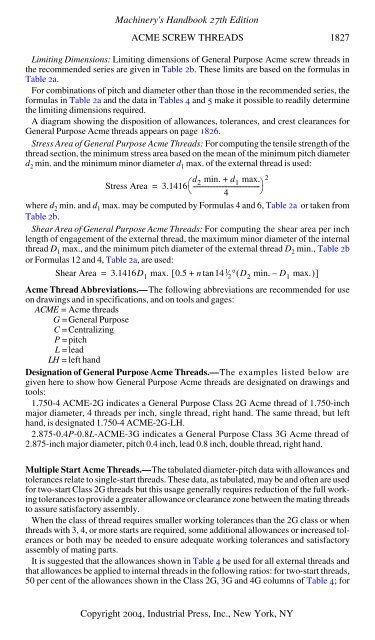Threads and Threading - Sportpilot.info
Threads and Threading - Sportpilot.info
Threads and Threading - Sportpilot.info
You also want an ePaper? Increase the reach of your titles
YUMPU automatically turns print PDFs into web optimized ePapers that Google loves.
Machinery's H<strong>and</strong>book 27th Edition<br />
ACME SCREW THREADS 1827<br />
Limiting Dimensions: Limiting dimensions of General Purpose Acme screw threads in<br />
the recommended series are given in Table 2b. These limits are based on the formulas in<br />
Table 2a.<br />
For combinations of pitch <strong>and</strong> diameter other than those in the recommended series, the<br />
formulas in Table 2a <strong>and</strong> the data in Tables 4 <strong>and</strong> 5 make it possible to readily determine<br />
the limiting dimensions required.<br />
A diagram showing the disposition of allowances, tolerances, <strong>and</strong> crest clearances for<br />
General Purpose Acme threads appears on page 1826.<br />
Stress Area of General Purpose Acme <strong>Threads</strong>: For computing the tensile strength of the<br />
thread section, the minimum stress area based on the mean of the minimum pitch diameter<br />
d 2 min. <strong>and</strong> the minimum minor diameter d 1 max. of the external thread is used:<br />
Stress Area 3.1416<br />
where d2 min. <strong>and</strong> d1 max. may be computed by Formulas 4 <strong>and</strong> 6, Table 2a or taken from<br />
Table 2b.<br />
Shear Area of General Purpose Acme <strong>Threads</strong>: For computing the shear area per inch<br />
length of engagement of the external thread, the maximum minor diameter of the internal<br />
thread D1 max., <strong>and</strong> the minimum pitch diameter of the external thread D2 min., Table 2b<br />
or Formulas 12 <strong>and</strong> 4, Table 2a, are used:<br />
d2 min. d1 max. +<br />
⎛------------------------------------------- ⎞<br />
⎝ 4 ⎠<br />
2<br />
=<br />
Shear Area 3.1416D1 max. 0.5 n 141 =<br />
[ + tan ⁄ 2 ° ( D2 min. – D1 max. ) ]<br />
Acme Thread Abbreviations.—The following abbreviations are recommended for use<br />
on drawings <strong>and</strong> in specifications, <strong>and</strong> on tools <strong>and</strong> gages:<br />
ACME = Acme threads<br />
G=General Purpose<br />
C=Centralizing<br />
P=pitch<br />
L=lead<br />
LH = left h<strong>and</strong><br />
Designation of General Purpose Acme <strong>Threads</strong>.—The examples listed below are<br />
given here to show how General Purpose Acme threads are designated on drawings <strong>and</strong><br />
tools:<br />
1.750-4 ACME-2G indicates a General Purpose Class 2G Acme thread of 1.750-inch<br />
major diameter, 4 threads per inch, single thread, right h<strong>and</strong>. The same thread, but left<br />
h<strong>and</strong>, is designated 1.750-4 ACME-2G-LH.<br />
2.875-0.4P-0.8L-ACME-3G indicates a General Purpose Class 3G Acme thread of<br />
2.875-inch major diameter, pitch 0.4 inch, lead 0.8 inch, double thread, right h<strong>and</strong>.<br />
Multiple Start Acme <strong>Threads</strong>.—The tabulated diameter-pitch data with allowances <strong>and</strong><br />
tolerances relate to single-start threads. These data, as tabulated, may be <strong>and</strong> often are used<br />
for two-start Class 2G threads but this usage generally requires reduction of the full working<br />
tolerances to provide a greater allowance or clearance zone between the mating threads<br />
to assure satisfactory assembly.<br />
When the class of thread requires smaller working tolerances than the 2G class or when<br />
threads with 3, 4, or more starts are required, some additional allowances or increased tolerances<br />
or both may be needed to ensure adequate working tolerances <strong>and</strong> satisfactory<br />
assembly of mating parts.<br />
It is suggested that the allowances shown in Table 4 be used for all external threads <strong>and</strong><br />
that allowances be applied to internal threads in the following ratios: for two-start threads,<br />
50 per cent of the allowances shown in the Class 2G, 3G <strong>and</strong> 4G columns of Table 4; for<br />
Copyright 2004, Industrial Press, Inc., New York, NY













